Collision Avoidance Pattern with Collective Wisdom: Ship Action Decision-Making Azimuth Map Construction Based on COLREGs
Abstract
1. Introduction
2. Literature Review
2.1. Related Research on Ship Encounter Scenarios
2.2. Related Research on Ship Behavior Mining
3. Methodology
3.1. AIS Data Preprocessing
3.2. Ship Encounter State Identification
3.2.1. Encounter Situation Classification
3.2.2. Spatiotemporal Modeling of Collision Risk
3.3. Ship Collision Avoidance Case Extraction
3.3.1. Ship Encounter Case Mining Procedure
| Algorithm 1. Stage one: ship encounter case mining. |
| Input: DS = {Traj1, Traj2, …, Trajn}, Traji = (MMSIi, loni, lati, sogi, cogi, ti) |
| Output: EDS = {Traj1e, Traj2e, …, Trajne}, Trajie = {cogi, ri, AOBi, Si, caseIDi, situationi, ti} |
| Initialize: EDS = ∅; caseID = 0 |
| 1.for i in DS: |
| 2. get Traji and sorted by ti |
| 3. for u in DS: |
| 4. get Traju and sorted by tu |
| 5. if not Traji.MMSI == Traju.MMSI: |
| 6. Calculate VR, r, S, AOB, Cdiff, cpa, tcpa |
| 7. if S < 8 nmile: |
| 8. if cpa < 1.5 nm and tcpa > 0: |
| 9. if (0° ≤ AOB ≤ 6° or 354° ≤ AOB ≤ 360°) and 175° ≤ Cdiff ≤ 185°: |
| 10. situation = “Head-on” |
| 11. elif (112.5° ≤ AOB ≤ 247.5°) |
| and (0° ≤ Cdiff ≤ 67.5° or 292.5° ≤ Cdiff ≤ 360°): |
| 12. situation = “Overtaking” |
| 13. elif (6° ≤ AOB ≤ 112.5° or 247.5° ≤ AOB ≤ 354°) |
| and not (head-on/overtaking): |
| 14. situation = “Crossing” |
| 15. else end |
| 16.caseID + = 1 |
| 17.Trajie = {cogi, ri, AOBi, Si, caseIDi, situationi} |
| 18.EDS = {Traj1e, Traj2e, …, Trajne} |
| 19.Output EDS |
3.3.2. Ship Collision Avoidance Extraction
| Algorithm 2. Stage two: collision avoidance behavior extraction. |
| Input: EDS = {Traj1e, Traj2e, …, Trajne}, Trajie = {cogi, ri, AOBi, Si, caseIDi, situationi, ti} |
| Output: eps = {ep1, ep2, …, epn}, epi = {caseID, situation, S, AOB, r, action} |
| Initialize: : fixed window size = 8, s: sliding step = 1, eps = None, Ths = 6 |
| 1. for i in EDS: |
| 2. get Trajie and sort by ti |
| 3. dir = 0; cnt = 0; idx_turn = None |
| 4. for k in range (1, len(cog)): |
| 5. dC = cog[k] − cog[k−1] |
| 6. if dC > 0: cur_dir = +1 |
| 7. elif dC < 0: cur_dir = −1 |
| 8. else: cur_dir = 0 # no change |
| 9. if cur_dir ! = 0: |
| 10. if dir == 0: |
| 11. dir = cur_dir; cnt = 1 |
| 12. elif cur_dir == dir: cnt + = 1 |
| 13. else: dir = cur_dir; cnt = 1 |
| 14. if cnt >= Ths and idx_turn is None: |
| 15. idx_turn = k − Ths |
| 16. get Traj eidx_turn |
| 17. if idx_turn is None: continue |
| 18. CL_min = min(cog [0:idx_turn + 1]); CL_max = max(cog [0:idx_turn + 1]) |
| 19. for m in range(idx_turn, len(cog)): |
| 20. if CL_min <= cog[m] <= CL_max: |
| 21. if cog[idx_turn + Ths] > cog[idx_turn]: action = “Starboard” |
| 22. elif cog[idx_turn + Ths] < cog[idx_turn]: action = “Port” |
| 23. else: action = None |
| 24. break |
| 25. append Traj eidx_turn.(caseIDidx_turn, situationidx_turn, Sidx_turn, AOBidx_turn, ridx_turn) |
| and action to epi |
| 26.eps = {ep1, ep2, …, epn} |
| 27.Output eps |
3.4. Encounter Scenarios Standardization
3.5. Collision Avoidance Azimuth Partitioning Based on a Decision Tree
3.5.1. Problem Statement
3.5.2. Decision Tree Model
4. Results
4.1. Study Area and Data
4.2. Data Analysis
4.3. Encounter Situation Feature Partition
4.3.1. Head-On
4.3.2. Crossing
4.3.3. Overtaking
- When the own ship is the overtaking ship, the overtaking action is initiated at a distance of less than 3.2 nm.
- If the target ship is on the port side of the own ship and the direction of relative motion lies to the right of the relative bearing, the overtaking vessel alters to starboard.
- If the target ship is on the starboard side of the own ship and the direction of relative motion lies to the right of the relative bearing, the overtaking ship alters to starboard.
- If the target ship is on the port side of the own ship and the direction of relative motion lies to the left of the relative bearing, the overtaking ship alters to port.
- If the target ship is on the starboard side of the own ship and the direction of relative motion lies to the left of the relative bearing, the overtaking ship alters to port.
4.4. Data-Driven Ship Collision Avoidance Action Decision-Making Azimuth Map
5. Discussion
6. Conclusions
Author Contributions
Funding
Data Availability Statement
Acknowledgments
Conflicts of Interest
References
- UNCTAD. 50 Years of Review of Maritime Transport, 1968–2018: Reflecting on the Past, Exploring the Future. 2018. Available online: https://unctad.org/webflyer/50-years-review-maritime-transport-1968-2018-reflecting-past-exploring-future#tab-2 (accessed on 25 October 2025).
- Zhang, J.; Zhen, K. A Review of Ship Collision Avoidance System. Sci. Technol. Eng. 2019, 19, 32–39. [Google Scholar] [CrossRef]
- Han, C.W.; Lee, S.W.; Jin, E.S. Tracking of ARPA Radar Signals Based on UK–PDAF and Fusion with AIS Data. J. Ocean. Eng. Technol. 2023, 37, 38–48. [Google Scholar] [CrossRef]
- Carl, M. Human Factors at Sea: Common Patterns of Error in Groundings and Collisions. Marit. Policy Manag. 2009, 36, 21–38. [Google Scholar] [CrossRef]
- Hasan, U.; Ismail, C. Analysis and Assessment of Ship Collision Accidents Using Fault Tree and Multiple Correspondence Analysis. Ocean. Eng. 2022, 245, 110514. [Google Scholar] [CrossRef]
- Hilgert, H. Defining the Close-Quarters Situation at Sea. J. Navig. 1983, 36, 454–461. [Google Scholar] [CrossRef]
- International Transport Workers’ Federation. Transport 2040: Impact of Technology on Seafarers—The Future of Work. 2019. Available online: https://commons.wmu.se/cgi/viewcontent.cgi?article=1091&context=lib_reports (accessed on 26 October 2025).
- Yu, H.; Wu, W.; Zhang, X.; Fang, Z.; Fu, X.; Xu, L.; Liu, J. Optimization-based global liquefied natural gas shipping network management for emission reduction. Ocean. Eng. 2025, 321, 120366. [Google Scholar] [CrossRef]
- Yu, H.; Cui, X.; Bai, X.; Chen, C.; Xu, L. Incorporating graph theory and time series analysis for fine-grained traffic flow prediction in port areas. Ocean. Eng. 2025, 335, 121693. [Google Scholar] [CrossRef]
- Kuwata, Y.; Wolf, M.T.; Zarzhitsky, D. Safe maritime navigation with COLREGS using Velocity Obstacles. IEEE J. Ocean. Eng. 2014, 39, 110–119. [Google Scholar] [CrossRef]
- Naeem, W.; Irwin, G.W.; Yang, A. COLREGs-based collision avoidance strategies for unmanned surface vehicles. Mechatronics 2012, 22, 669–678. [Google Scholar] [CrossRef]
- Zheng, Z.; Wu, Z. Research on decision-making of multi-ship meetings avoidance I. definition, division and classification of multi-ship meetings. Navig. Technol. 2000, 4, 9–12. [Google Scholar] [CrossRef]
- Wu, G.; Shi, D.; Guo, J. Deliberative collision avoidance for unmanned surface vehicle based on the directional weight. Shanghai Jiaotong Univ. (Sci.) 2016, 21, 307–312. [Google Scholar] [CrossRef]
- Kim, D.; Ahn, K.; Shim, S. A study on the verification of collision avoidance support system in real voyages. In Proceedings of the 2015 International Association of Institutes of Navigation World Congress (IAIN), Prague, Czech Republic, 20–23 October 2015. [Google Scholar] [CrossRef]
- Perera, L.P.; Carvalho, J.P.; Soares, C.G. Smooth transition between fuzzy regions to overcome failures in fuzzy membership functions of decisions in collision avoidance of ocean navigation. In Proceedings of the 25th Mini-EURO Conference on Uncertainty and Robustness in Planning and Decision Making, Coimbra, Portugal, 15–17 April 2010. [Google Scholar]
- Gao, M.; Shi, G.Y.; Liu, J. Ship encounter azimuth map division based on automatic identification system data and support vector classification. Ocean. Eng. 2020, 213, 107636. [Google Scholar] [CrossRef]
- Wang, Y.; Liu, J.; Liu, W.; Liu, Y.; Yuan, Z. Data-driven methods for detection of abnormal ship behavior: Progress and trends. Ocean. Eng. 2023, 271, 113673. [Google Scholar] [CrossRef]
- Jin, J.; Zhou, Z.; Zhang, B.; Chen, Y.; Wei, X. Research on USV Navigation Simulation Key Technologies. J. Syst. Simul. 2021, 33, 2846–2853. [Google Scholar] [CrossRef]
- Ding, Z.; Zhang, X.; Wang, C.; Li, Q.; An, L. Intelligent collision avoidance decision-making method for unmanned ships based on driving practice. Chin. J. Ship Res. 2021, 16, 96–104. [Google Scholar] [CrossRef]
- Zhou, Y.; Daamen, W.; Vellinga, T.; Hoogendoorn, S.P. Ship behavior during encounters in ports and waterways based on AIS data: From theoretical definitions to empirical findings. Ocean. Eng. 2023, 272, 113879. [Google Scholar] [CrossRef]
- Rong, H.; Teixeira, A.P.; Guedes Soares, C. Data mining approach to shipping route characterization and anomaly detection based on AIS data. Ocean. Eng. 2020, 198, 106936. [Google Scholar] [CrossRef]
- Cai, Z.; Fan, Q.; Li, L.; Yu, L.; Li, C. An efficient Meta-VSW method for ship behaviors recognition and application. Ocean. Eng. 2024, 311, 118870. [Google Scholar] [CrossRef]
- Chen, X.; Liu, Y.; Kamalasudhan, A.; Zhang, X. A ship movement classification based on Automatic Identification System data using Convolutional Neural Network. Ocean. Eng. 2020, 218, 108182. [Google Scholar] [CrossRef]
- Chen, X.; Wei, C.; Zhou, G.; Wu, H.; Wang, Z.; Biancardo, S.A. Automatic Identification System (AIS) Data Supported Ship Trajectory Prediction and Analysis via a Deep Learning Model. J. Mar. Sci. Eng. 2022, 10, 1314. [Google Scholar] [CrossRef]
- Gao, M.; Shi, G.Y.; Li, S. Online Prediction of Ship Behavior with Automatic Identification System Sensor Data Using Bidirectional Long Short-Term Memory Recurrent Neural Network. Sensors 2018, 18, 4211. [Google Scholar] [CrossRef]
- Wang, F.; Lei, Y.; Liu, Z.; Wang, X.; Ji, S.; Anthony, K.H. Fast and parameter-light rare behavior detection in maritime trajectories. Inf. Process. Manag. 2020, 57, 102268. [Google Scholar] [CrossRef]
- Zhang, B.; Katsutoshi, H.; Ren, H.; Wang, D.; Li, H. Ship Anomalous Behavior Detection Using Clustering and Deep Recurrent Neural Network. J. Mar. Sci. Eng. 2023, 11, 763. [Google Scholar] [CrossRef]
- Ma, Q.; Lian, S.; Zhang, D.; Lang, X.; Rong, H.; Mao, W.; Zhang, M. A machine learning method for the recognition of ship behavior using AIS data. Ocean. Eng. 2025, 315, 119791. [Google Scholar] [CrossRef]
- Rong, H.; Teixeira, A.P.; Guedes Soares, C. Ship collision avoidance behaviour recognition and analysis based on AIS data. Ocean. Eng. 2022, 245, 110479. [Google Scholar] [CrossRef]
- Liu, C.; Zhang, S.; Li, P.; Li, B.; Li, B. Typical Ship Trajectory Extraction Method Considering Ground Speed and Heading. J. Transp. Syst. Eng. Inf. Technol. 2022, 22, 114–123. [Google Scholar] [CrossRef]
- Jiang, H.; Gao, C.; Ma, Y. Ship Trajectory Compression Based on FP-TSDP Algorithm. Unmanned Syst. Technol. 2022, 5, 36–42. [Google Scholar] [CrossRef]
- Yu, H.; Fang, Q.; Fang, Z.; Xu, L.; Liu, J. Carbon footprints: Uncovering spatiotemporal dynamics of global container ship emissions during 2015–2021. Mar. Pollut. Bull. 2024, 209, 117165. [Google Scholar] [CrossRef]
- Qu, X.; Meng, Q.; Su, L. Ship collision risk assessment for the Singapore Strait. Accid. Anal. Prev. 2011, 43, 2030–2036. [Google Scholar] [CrossRef]
- Zhang, J.; Liu, J.; Hirdaris, S.; Zhang, M.; Tian, W. An Interpretable Knowledge-Based Decision Support Method for Ship Collision Avoidance Using AIS Data. Reliab. Eng. Syst. Saf. 2023, 230, 108919. [Google Scholar] [CrossRef]
- He, Y.X. Automatic Collision-Avoidance Modeling and Simulation Under Rule Quantification Analysis. Doctoral Dissertation, Wuhan University of Technology, Wuhan, China, 2015. [Google Scholar]
- Zhou, Y.; Tiedo, V.; Serge, P.H. Ship Classification Based on Ship Behavior Clustering from AIS Data. Ocean. Eng. 2019, 175, 176–187. [Google Scholar] [CrossRef]
- Zhou, Y.; Tiedo, V.; Serge, P.H. Impacts of Wind and Current on Ship Behavior in Ports and Waterways: A Quantitative Analysis Based on AIS Data. Ocean. Eng. 2020, 213, 107774. [Google Scholar] [CrossRef]
- Weng, J.; Zhou, Y.; Chen, P.; Wu, X. Ship Watchkeeping and Collision Avoidance; Wuhan University of Technology Press: Wuhan, China, 2024. [Google Scholar]
- Fan, Y.; Sun, Z.; Wang, G. A Novel Reinforcement Learning Collision Avoidance Algorithm for USVs Based on Maneuvering Characteristics and COLREGs. Sensors 2022, 22, 2099. [Google Scholar] [CrossRef] [PubMed]
- Lee, Y.S.; Park, J.M.; Young, J. A Study on the Initial Action of Navigators to Avoid Risk of Collision at Sea. J. Navig. Port. Researc. 2014, 38, 327–333. [Google Scholar] [CrossRef]
- Chen, S.; Wang, Z.; Gong, B. A Data-Mining Model for Ship Collision-Avoidance Turning Points Based on the Sliding-Window Algorithm. Navig. China 2025, 48, 124–131. [Google Scholar]
- Chen, S.; Zhang, C.; Wu, L.; Wang, Z.; Wu, W.; Li, S.; Gao, H. Collision Avoidance Behavior Mining Model Considering Encounter Scenarios. Appl. Sci. 2025, 15, 2616. [Google Scholar] [CrossRef]
- Silva, C.S.; Borba, F.; De, S.L.; Pimentel, M.F.; Pontes, M.J.C.; Honorato, R.S.; Pasquini, C. Classification of blue pen ink using infrared spectroscopy and linear discriminant analysis. Microchem 2013, 109, 122–127. [Google Scholar] [CrossRef]
- Liao, J.; Chin, K.V. Logistic regression for disease classification using microarray data: Model selection in a large p and small n case. Bioinformatics 2007, 23, 1945–1951. [Google Scholar] [CrossRef]
- Zhang, M.; Huang, L.; Wen, Y.; Zhang, J.; Huang, Y.; Zhu, M. Short-Term Trajectory Prediction of Maritime Vessel Using k-Nearest Neighbor Points. J. Mar. Sci. Eng. 2022, 10, 1939. [Google Scholar] [CrossRef]
- Yang, Z.; Teixeira, A.P. Comparative analysis of the impact of new inspection regime on port state control inspection. Transp. Policy 2020, 92, 65–80. [Google Scholar] [CrossRef]
- Zheng, K.; Chen, Y.; Jiang, Y.; Qiao, S. A SVM based ship collision risk assessment algorithm. Ocean. Eng. 2020, 202, 107062. [Google Scholar] [CrossRef]
- Bart, V.R.; Rudy, R.N.; Rommert, D. Real-time container transport planning with decision trees based on offline obtained optimal solutions. Decis. Support Syst. 2016, 89, 1–16. [Google Scholar] [CrossRef]
- Chen, J.; Zhuang, C.; Shi, J.; Jiang, H.; Xu, J.; Liu, J. Risk factors extraction and analysis of Chinese ship collision accidents based on knowledge graph. Ocean. Eng. 2025, 322, 120536. [Google Scholar] [CrossRef]
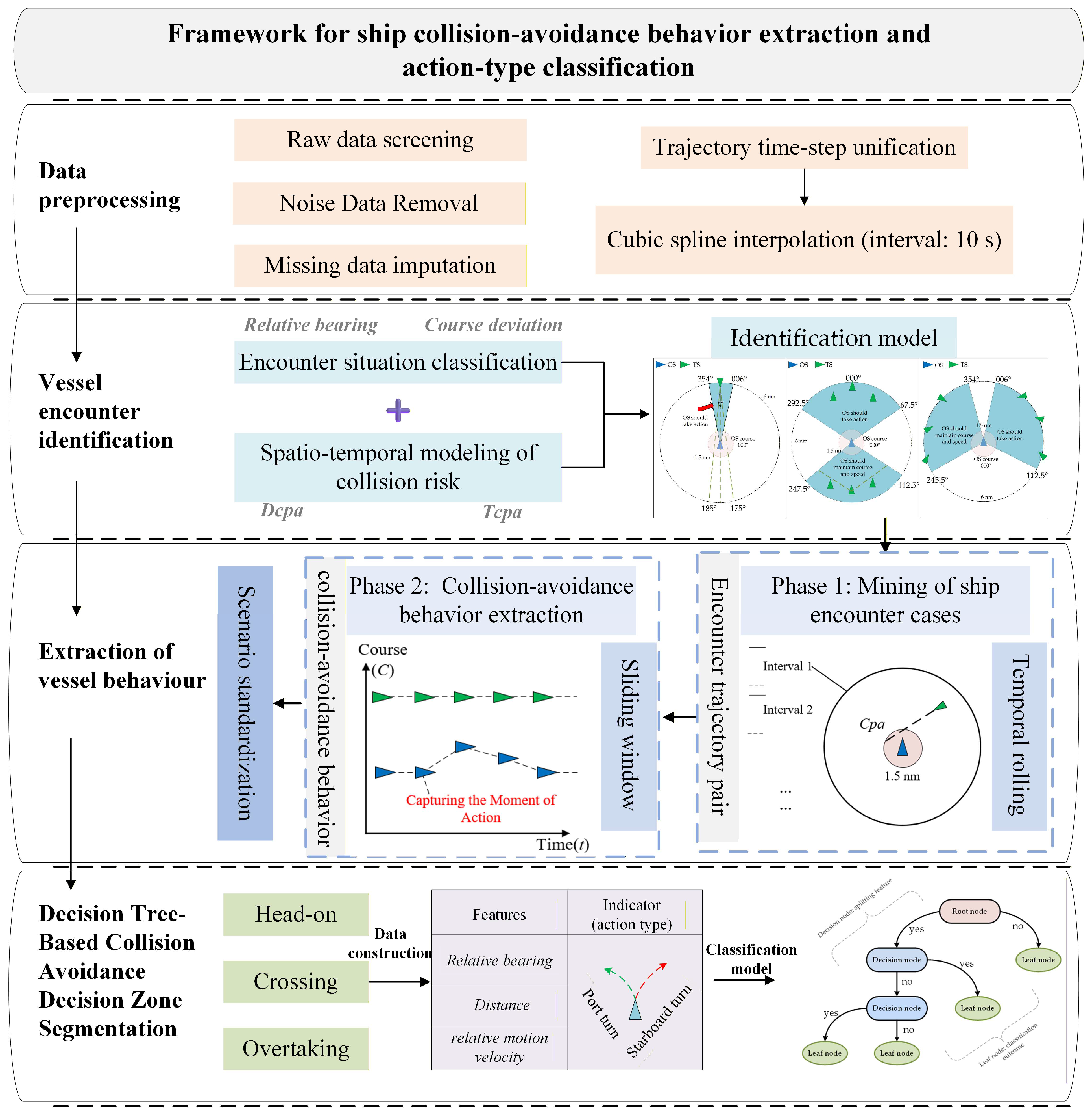
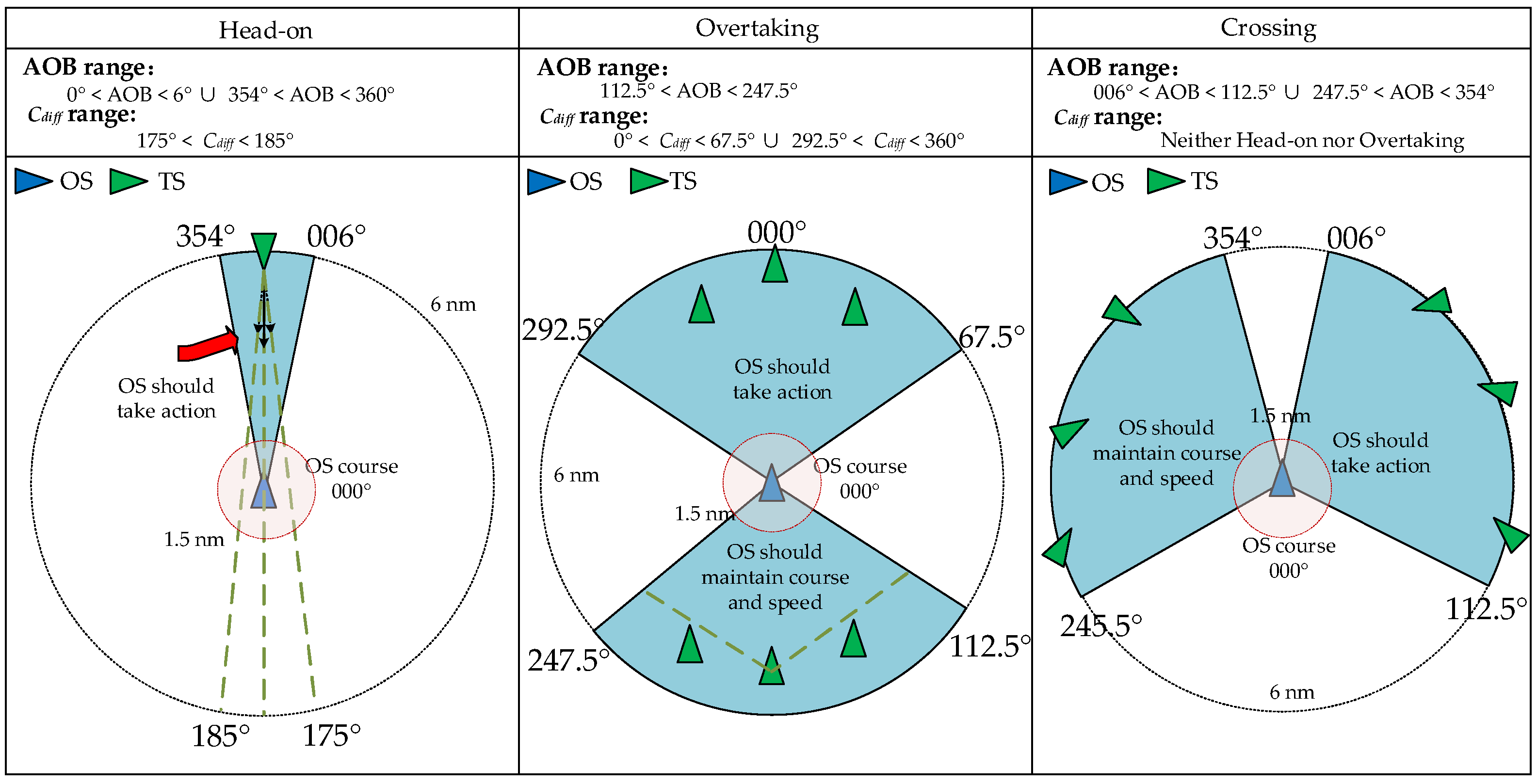

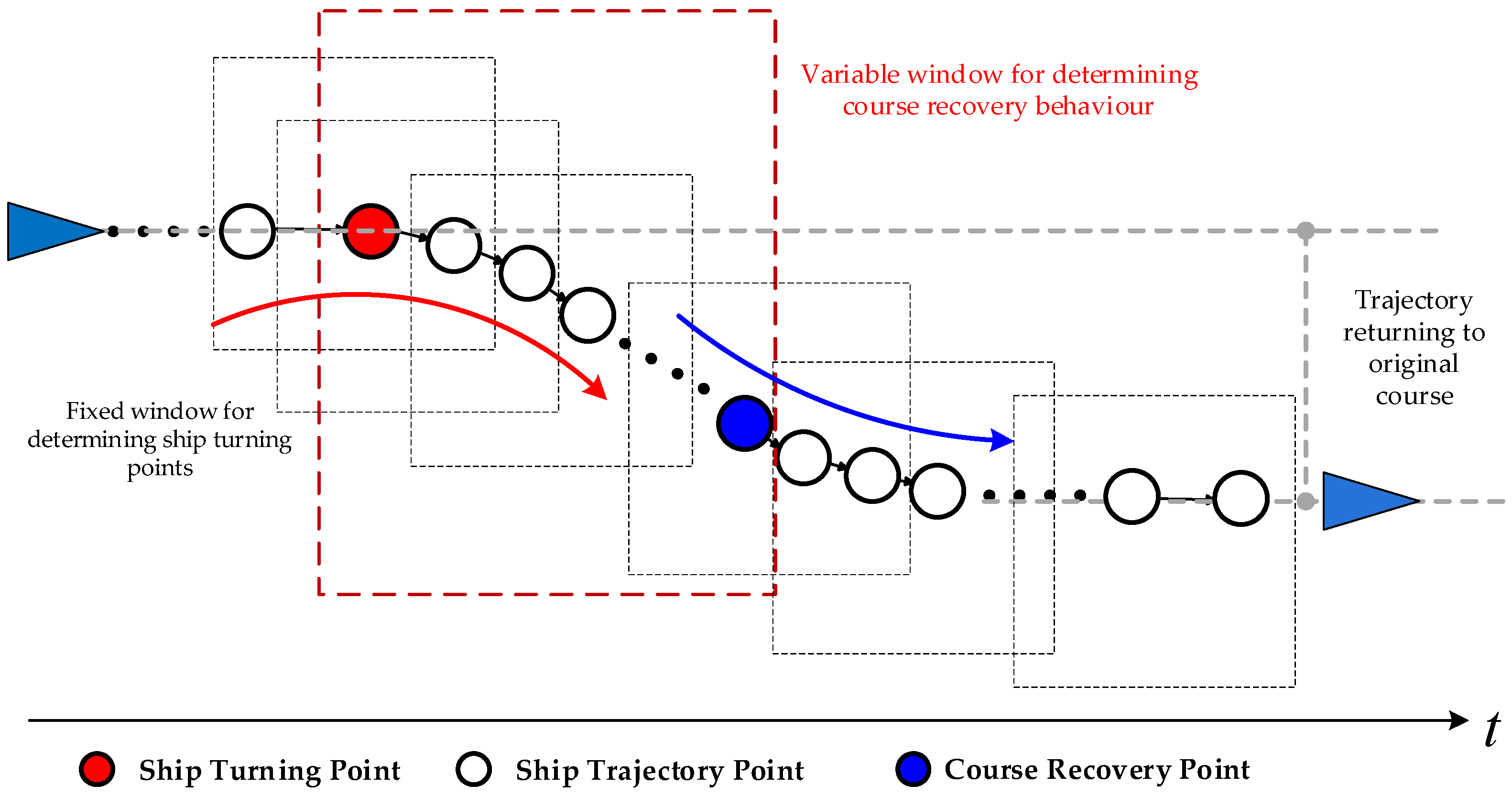

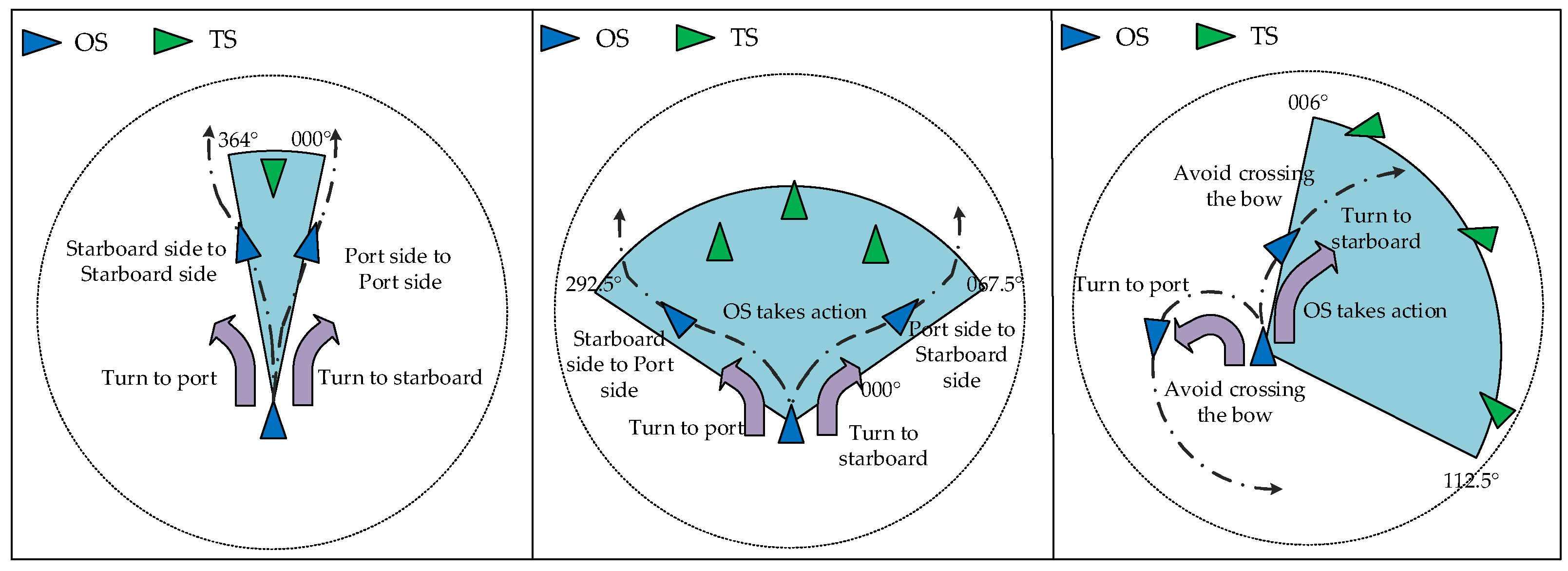



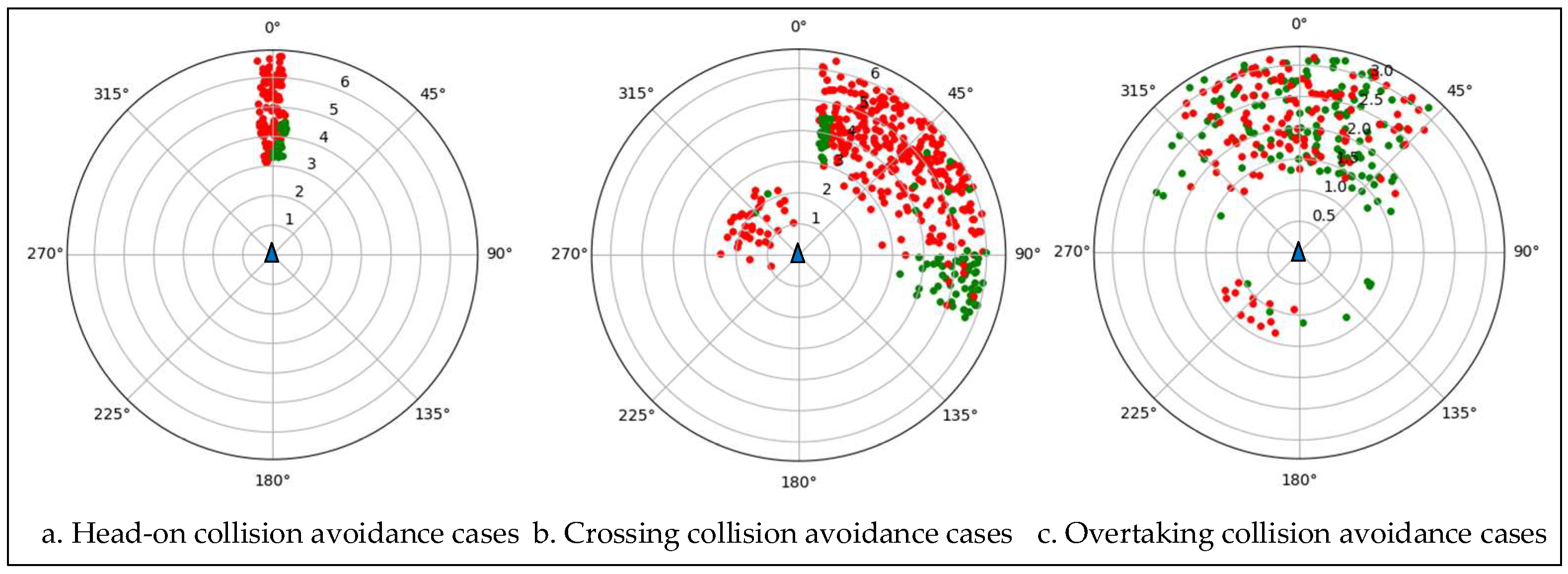

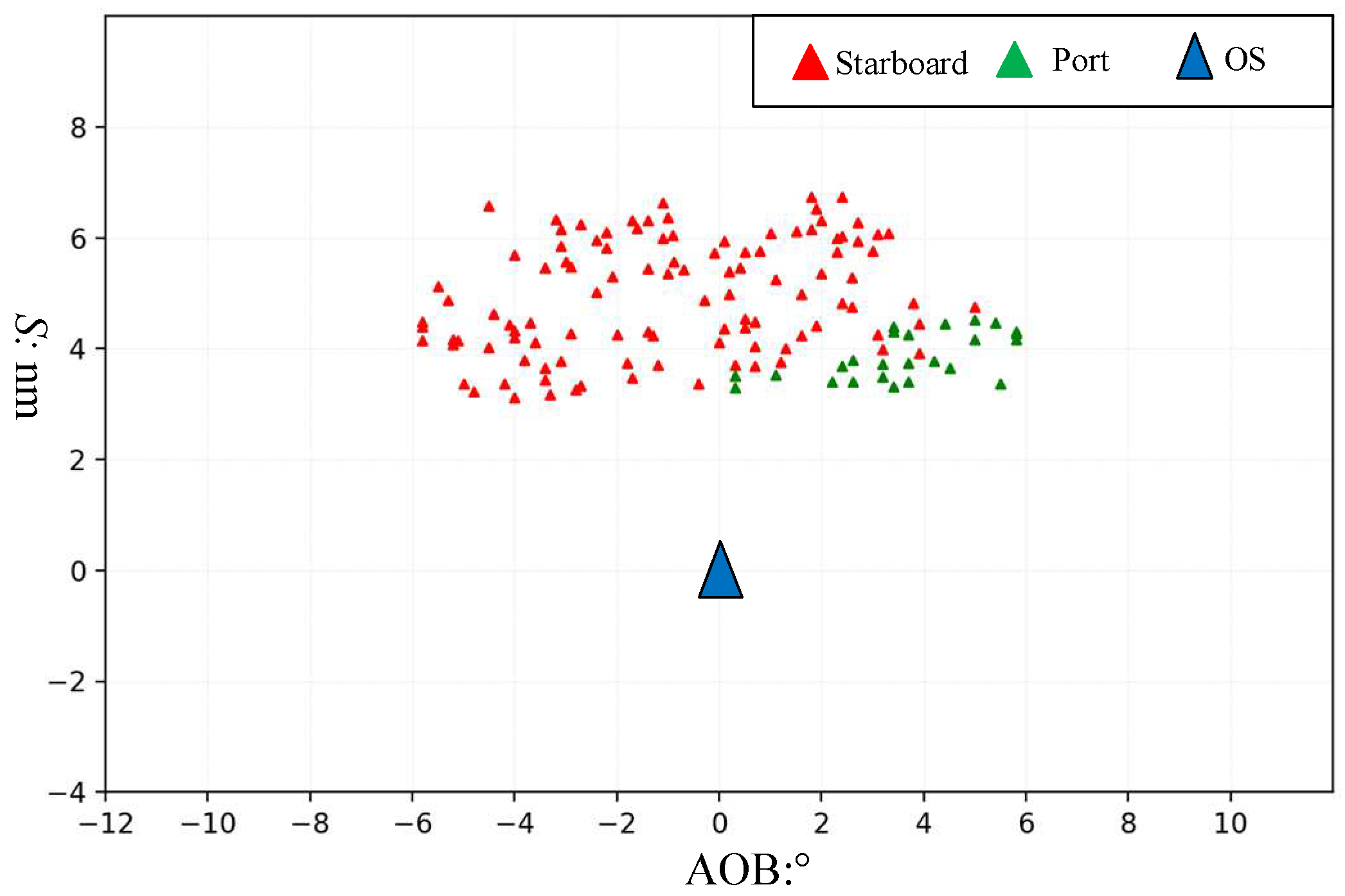
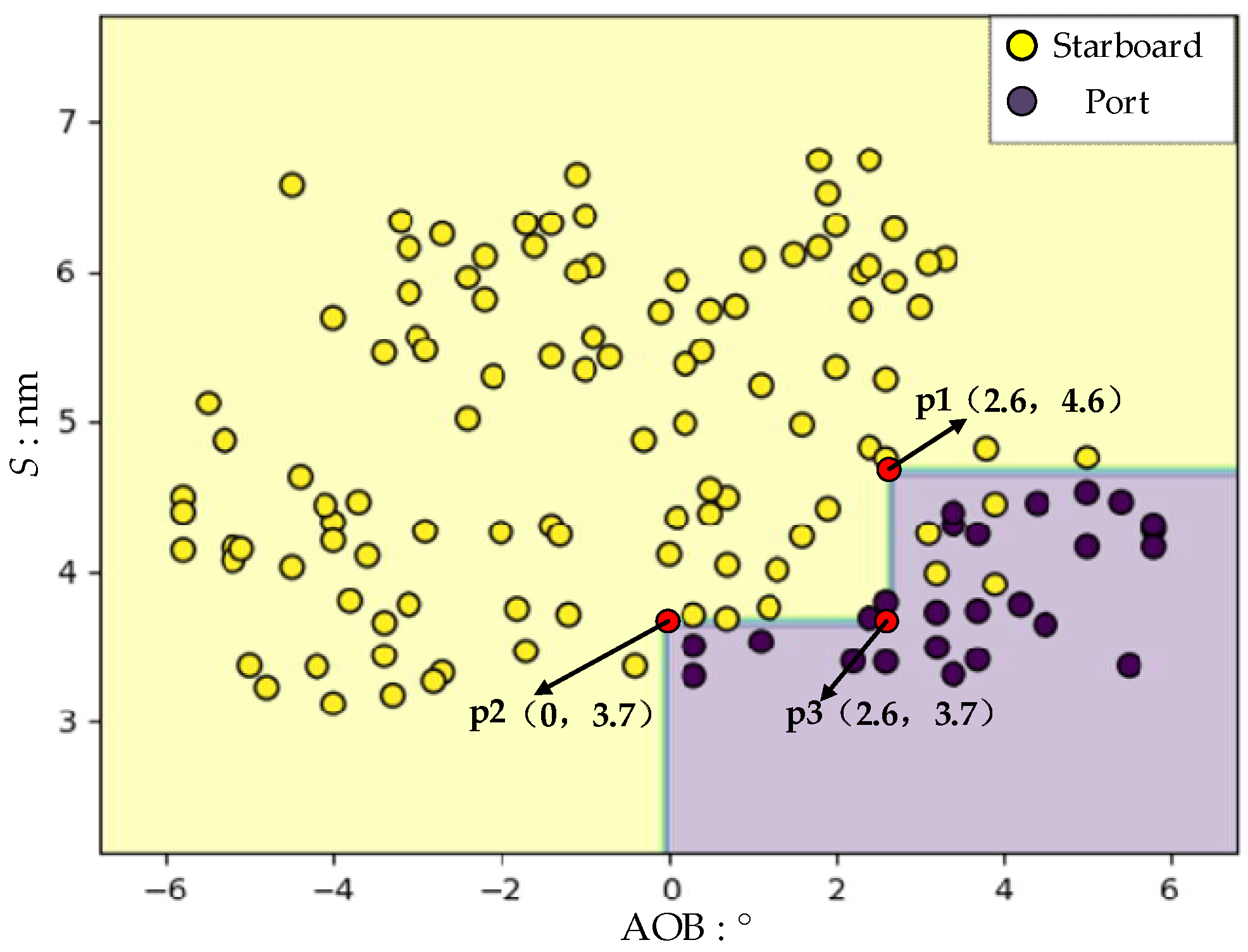

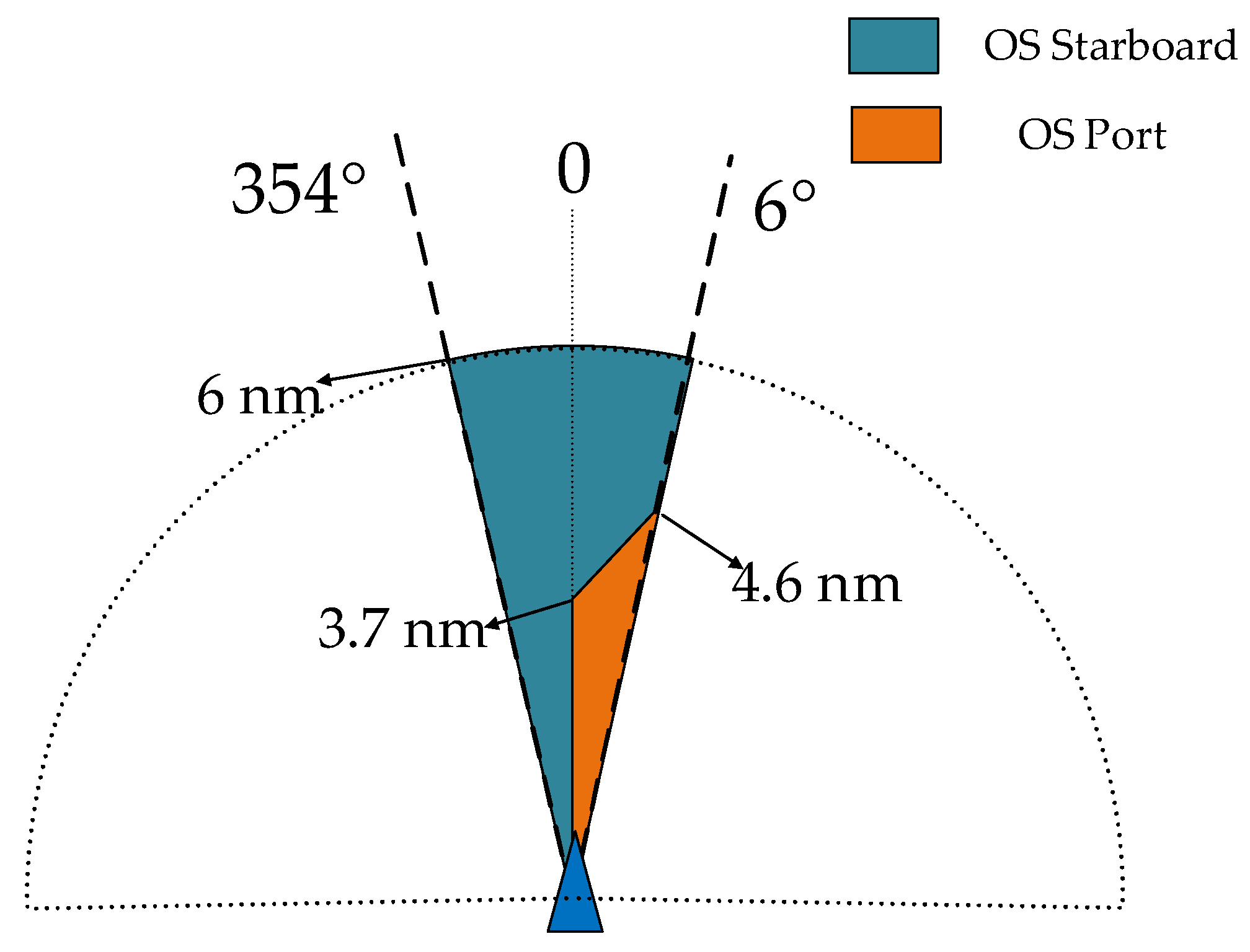

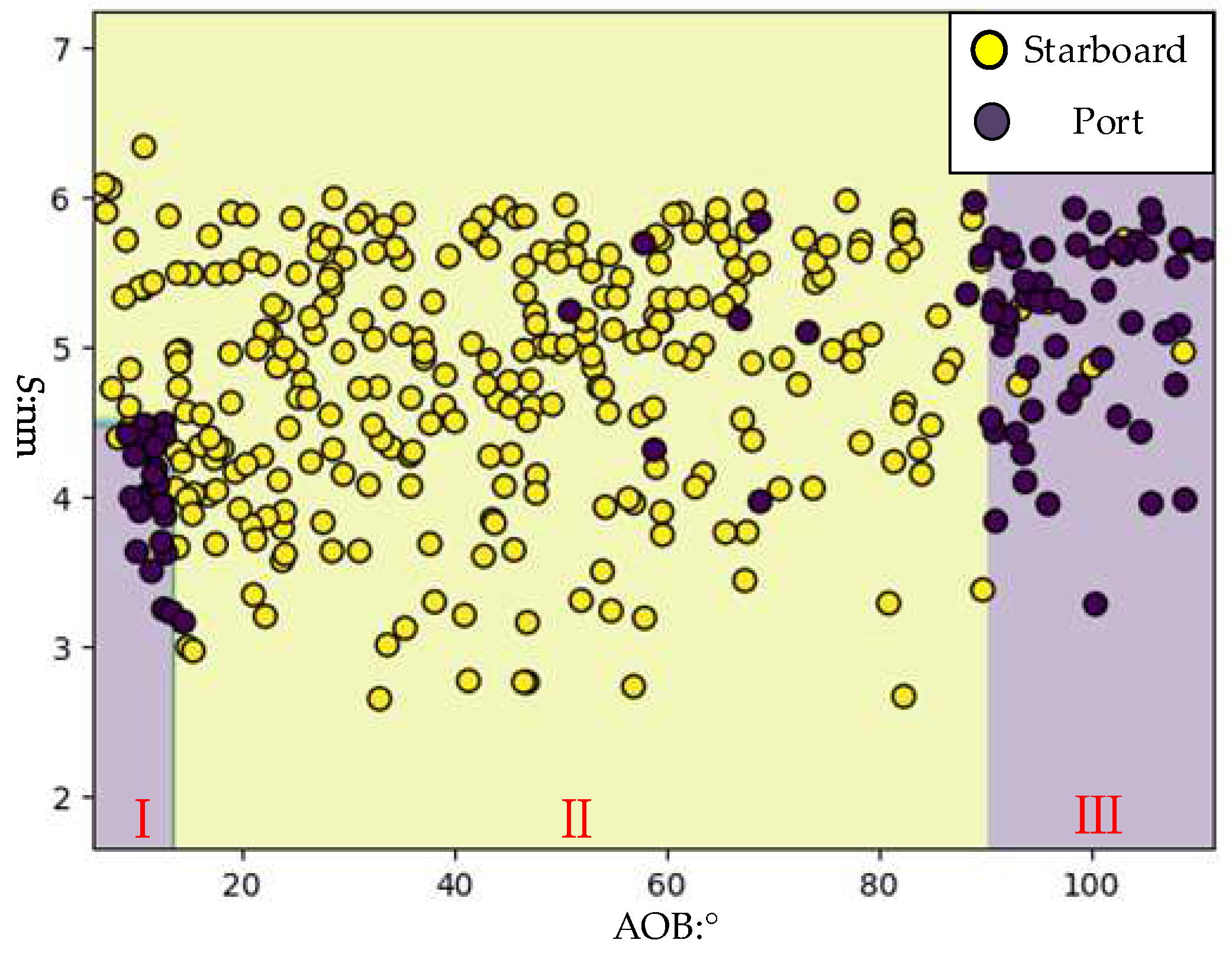




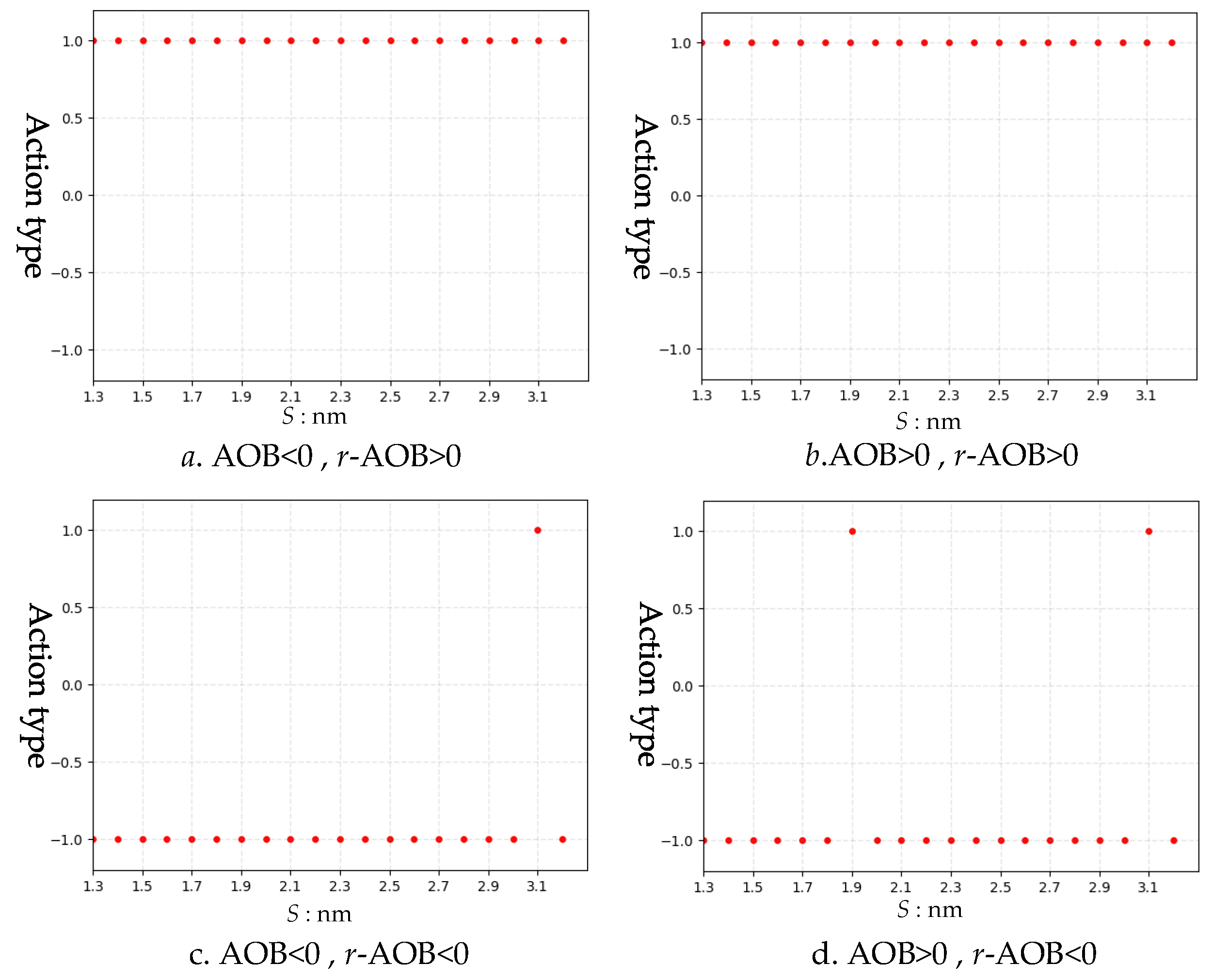
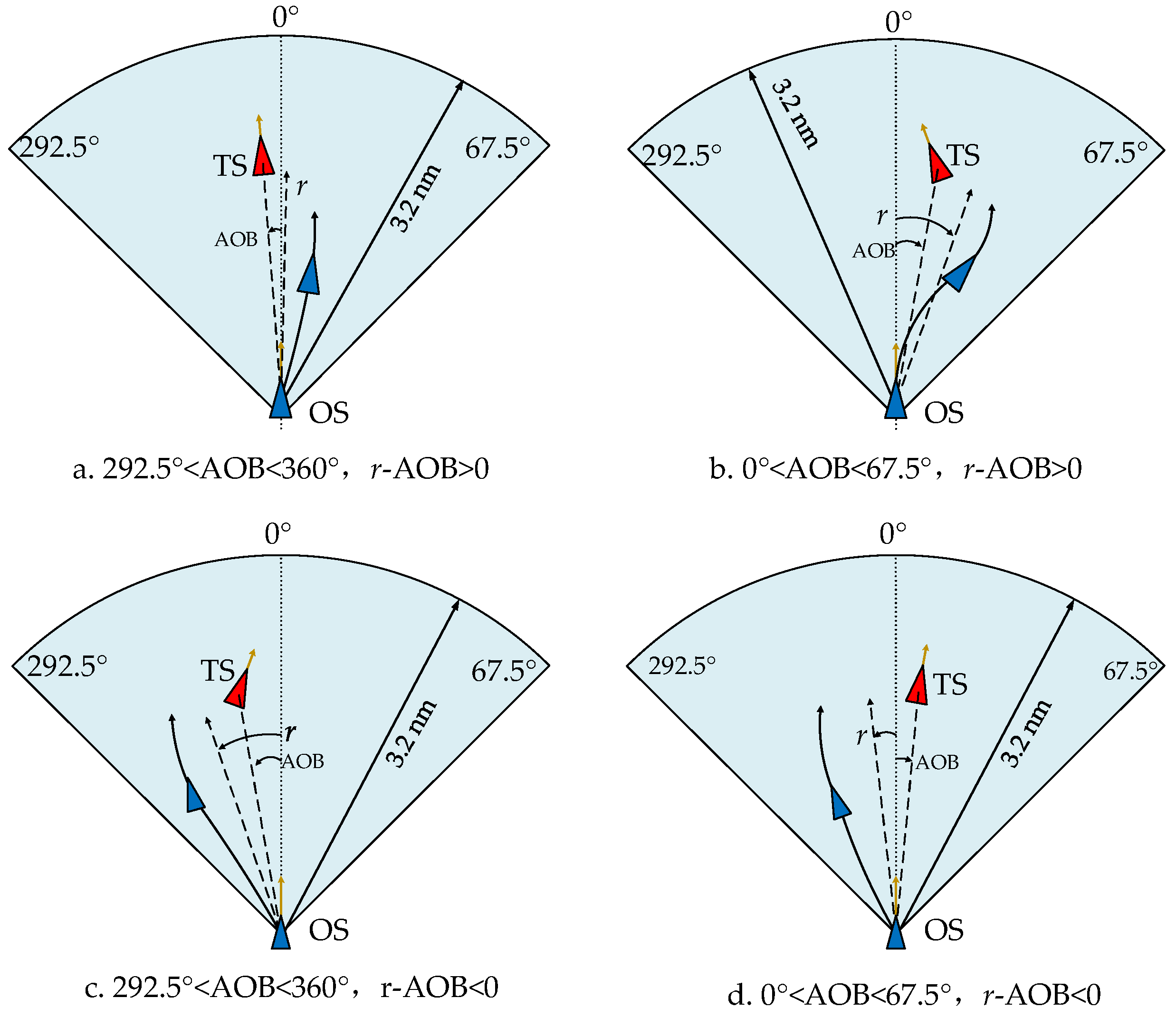
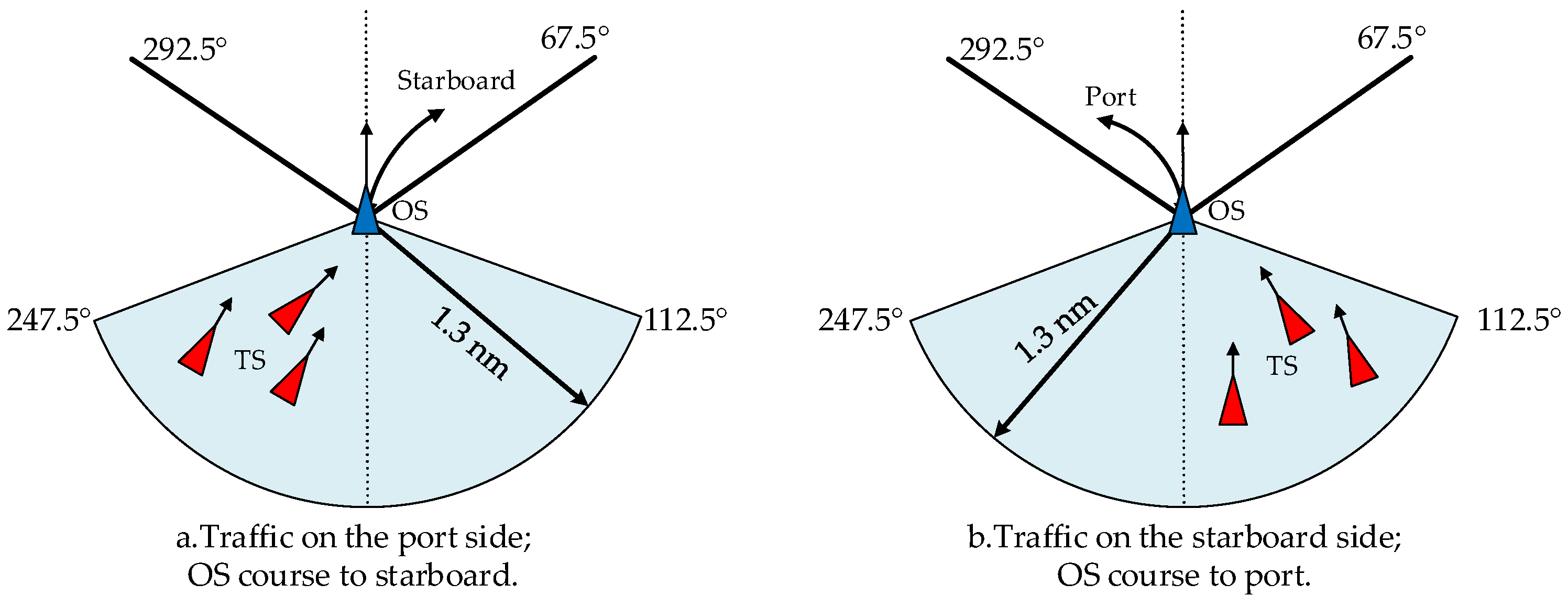
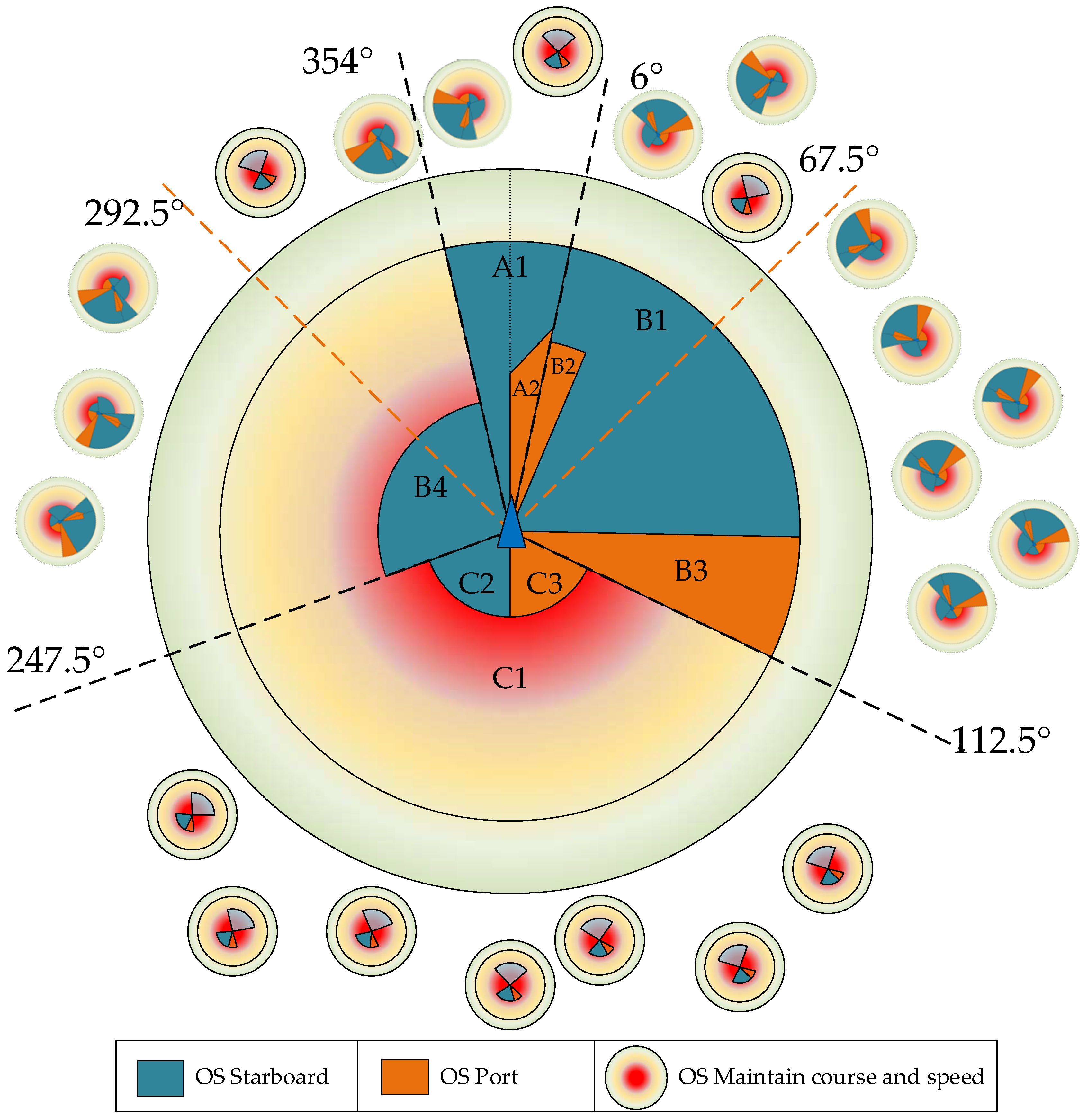
| Situation | AOB: ° | Cdiff: ° |
|---|---|---|
| Head-on | [000°~006°]||[354°~360°] | [175°~185°] |
| Overtaking | [0°~67.5°]||[292.5°~360°] | [0°~67.5°]||[292.5°~360°] |
| Crossing | [6°~112.5°]||[247.5°~354°] | Neither Head-on nor Overtaking |
| AOB: ° | S: nm | Action | AOB: ° | S: nm | Action |
|---|---|---|---|---|---|
| 3.9 | 4.446 | Starboard | −3.4 | 3.435 | Starboard |
| 2.4 | 4.827 | Starboard | 2.4 | 3.685 | Port |
| −0.1 | 5.730 | Starboard | 0 | 4.113 | Starboard |
| 0.3 | 3.501 | Port | 3.0 | 5.662 | Starboard |
| 1.3 | 4.012 | Starboard | −1.9 | 4.418 | Starboard |
| −1.2 | 3.708 | Starboard | 3.4 | 3.112 | Port |
| 0.7 | 3.681 | Starboard | −1.7 | 3.446 | Starboard |
| 3.7 | 3.410 | Port | −4.2 | 4.439 | Starboard |
| AOB: ° | S: nm | Action | AOB: ° | S: nm | Action |
|---|---|---|---|---|---|
| 33.7 | 3.015 | Starboard | 21.9 | 4.275 | Starboard |
| 35.4 | 3.126 | Starboard | 73.9 | 4.060 | Starboard |
| 46.7 | 5.542 | Starboard | 100.4 | 3.287 | Port |
| 35.1 | 5.591 | Starboard | 13.4 | 3.231 | Port |
| 82.3 | 5.847 | Starboard | 59.1 | 4.200 | Starboard |
| … | … | … | … | … | … |
| 90.9 | 5.313 | Port | 67.6 | 3.769 | Starboard |
| 16.3 | 4.551 | Starboard | 108.9 | 3.9 | Port |
| 24.1 | 3.62 | Starboard | 82.4 | 2.761 | Starboard |
| 102.6 | 4.54 | Port | 12.6 | 3.254 | Port |
| 44.4 | 2.775 | Starboard | 59.6 | 3.9 | Starboard |
| AOB: ° | S: nm | Action | AOB: ° | S: nm | Action |
|---|---|---|---|---|---|
| 299.5 | 1.714 | Starboard | 323.2 | 2.391 | Starboard |
| 320.5 | 2.006 | Starboard | 342.0 | 2.194 | Starboard |
| 339.8 | 1.782 | Starboard | 303.9 | 1.222 | Starboard |
| … | … | … | … | … | … |
| 301.1 | 1.480 | Starboard | 333.5 | 2.215 | Port |
| 300.0 | 2.412 | Starboard | 342.2 | 1.510 | Starboard |
| AOB: ° | S: nm | r: ° | Action |
|---|---|---|---|
| 352.2 | 1.919 | 359.5 | Starboard |
| 358.6 | 2.395 | 359.9 | Starboard |
| 8.6 | 1.521 | 20.4 | Starboard |
| 359.5 | 1.874 | 336.4 | Port |
| 4.3 | 3.112 | 7.3 | Starboard |
| 352.4 | 2.608 | 348.6 | Port |
| 8.4 | 1.655 | 12.7 | Starboard |
| … | … | … | … |
| 22.1 | 2.873 | 17.9 | Port |
| 356.3 | 2.476 | 357.0 | Starboard |
| 357.8 | 2.703 | 357.7 | Port |
| 350.2 | 1.966 | 1.5 | Starboard |
| 8.1 | 1.971 | 4.6 | Port |
| 39.8 | 2.979 | 41.0 | Starboard |
| AOB: ° | S: nm | r: ° | Action |
|---|---|---|---|
| 144.1 | 1.264 | 139.5 | Port |
| 238.6 | 1.204 | 234.4 | Starboard |
| 206.7 | 1.059 | 214.3 | Port |
| … | … | … | … |
| 216.5 | 1.122 | 216.2 | Starboard |
| 222.4 | 1.1 | 218.6 | Starboard |
| AOB: ° | S: nm | r-AOB | Action |
|---|---|---|---|
| −7.6 | 2.101 | 3.7 | Starboard |
| −3.2 | 2.692 | 2.7 | Starboard |
| 2.2 | 2.916 | −3.9 | Port |
| −1.4 | 2.395 | 1.3 | Starboard |
| 8.1 | 1.971 | −2.2 | Port |
| … | … | … | … |
| −4.28 | 2.238 | 4.1 | Starboard |
| 2.4 | 2.851 | −1.3 | Port |
| 3.4 | 2.305 | −4.2 | Port |
| 22.2 | 3.14 | 1.2 | Starboard |
| Encounter State | Encounter Situation | OS Responsibility | Action Conditions | Action Patterns |
|---|---|---|---|---|
| A1-A | Head-on | Equal responsibility | S < 6 | Starboard |
| A2-A | Head-on | Equal responsibility | S < 4.6 and 0 < AOB < 6 | Port |
| A-C1 | Overtaking | Overtaking ship | S < 3.2 and r-AOB > 0/r-AOB < 0 | Starboard/Port |
| C2-A | Overtaking | Ship being overtaken | S < 1.3 and 180 < AOB < 247.5 | Starboard |
| C3-A | Overtaking | Ship being overtaken | S < 1.3 and 112.5 < AOB < 180 | Port |
| B1-A,B4 | Crossing | Give-way ship | S < 6 and AOB < 90.3 | Starboard |
| B2-A,B1 | Crossing | Give-way ship | S < 4.5 and 6 < AOB < 13.6 | Port |
| B3-A,B4 | Crossing | Give-way ship | S < 6 and 90.3 < AOB < 112.5 | Port |
| B4-A,B | Crossing | Stand-on ship | S < 2.5 | Starboard |
| Others | No encounter | Maintain course and speed | Others | Maintain course and speed |
Disclaimer/Publisher’s Note: The statements, opinions and data contained in all publications are solely those of the individual author(s) and contributor(s) and not of MDPI and/or the editor(s). MDPI and/or the editor(s) disclaim responsibility for any injury to people or property resulting from any ideas, methods, instructions or products referred to in the content. |
© 2025 by the authors. Licensee MDPI, Basel, Switzerland. This article is an open access article distributed under the terms and conditions of the Creative Commons Attribution (CC BY) license (https://creativecommons.org/licenses/by/4.0/).
Share and Cite
Wang, Z.; Shao, F.; Zhang, C.; Yu, H.; Chen, S.; Wu, L. Collision Avoidance Pattern with Collective Wisdom: Ship Action Decision-Making Azimuth Map Construction Based on COLREGs. J. Mar. Sci. Eng. 2025, 13, 2240. https://doi.org/10.3390/jmse13122240
Wang Z, Shao F, Zhang C, Yu H, Chen S, Wu L. Collision Avoidance Pattern with Collective Wisdom: Ship Action Decision-Making Azimuth Map Construction Based on COLREGs. Journal of Marine Science and Engineering. 2025; 13(12):2240. https://doi.org/10.3390/jmse13122240
Chicago/Turabian StyleWang, Ziwei, Fei Shao, Chong Zhang, Hongchu Yu, Shuzhe Chen, and Lei Wu. 2025. "Collision Avoidance Pattern with Collective Wisdom: Ship Action Decision-Making Azimuth Map Construction Based on COLREGs" Journal of Marine Science and Engineering 13, no. 12: 2240. https://doi.org/10.3390/jmse13122240
APA StyleWang, Z., Shao, F., Zhang, C., Yu, H., Chen, S., & Wu, L. (2025). Collision Avoidance Pattern with Collective Wisdom: Ship Action Decision-Making Azimuth Map Construction Based on COLREGs. Journal of Marine Science and Engineering, 13(12), 2240. https://doi.org/10.3390/jmse13122240










